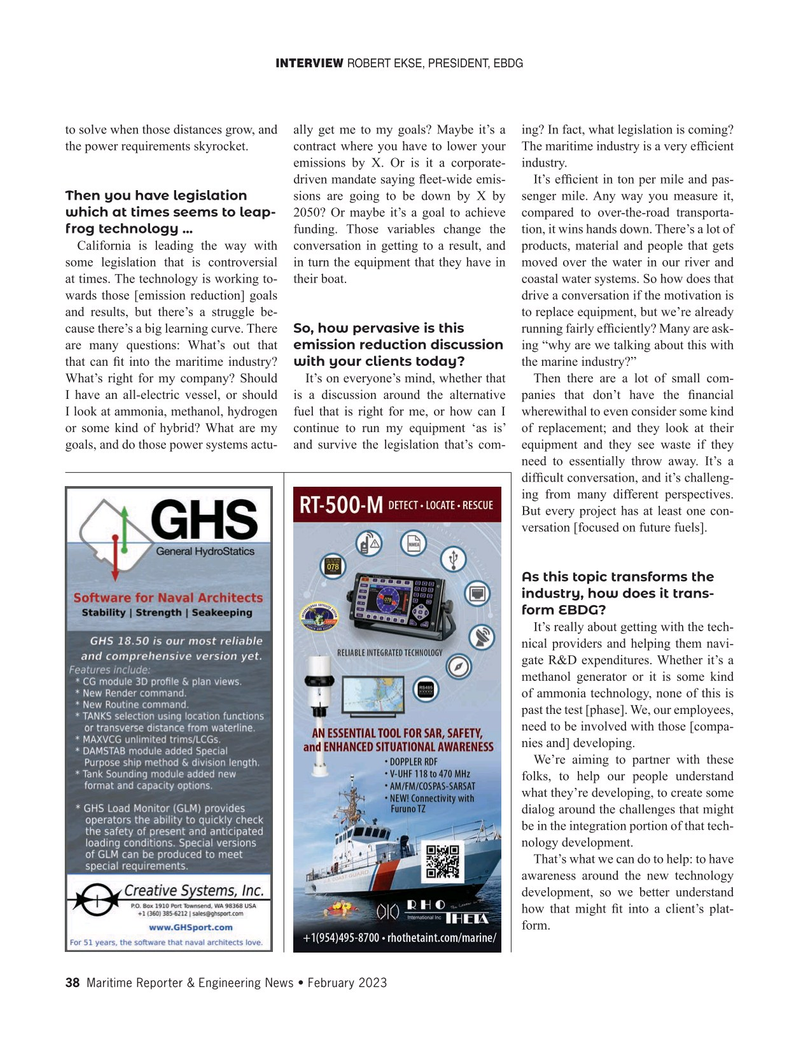
Page 38: of Maritime Reporter Magazine (February 2023)
Government Shipbuilding
Read this page in Pdf, Flash or Html5 edition of February 2023 Maritime Reporter Magazine
INTERVIEW ROBERT EKSE, PRESIDENT, EBDG to solve when those distances grow, and ally get me to my goals? Maybe it’s a ing? In fact, what legislation is coming? the power requirements skyrocket. contract where you have to lower your The maritime industry is a very ef? cient emissions by X. Or is it a corporate- industry. driven mandate saying ? eet-wide emis- It’s ef? cient in ton per mile and pas-
Then you have legislation sions are going to be down by X by senger mile. Any way you measure it, which at times seems to leap- 2050? Or maybe it’s a goal to achieve compared to over-the-road transporta- frog technology ... funding. Those variables change the tion, it wins hands down. There’s a lot of
California is leading the way with conversation in getting to a result, and products, material and people that gets some legislation that is controversial in turn the equipment that they have in moved over the water in our river and at times. The technology is working to- their boat. coastal water systems. So how does that wards those [emission reduction] goals drive a conversation if the motivation is and results, but there’s a struggle be- to replace equipment, but we’re already cause there’s a big learning curve. There So, how pervasive is this running fairly ef? ciently? Many are ask- are many questions: What’s out that emission reduction discussion ing “why are we talking about this with that can ? t into the maritime industry? with your clients today? the marine industry?”
What’s right for my company? Should It’s on everyone’s mind, whether that Then there are a lot of small com-
I have an all-electric vessel, or should is a discussion around the alternative panies that don’t have the ? nancial
I look at ammonia, methanol, hydrogen fuel that is right for me, or how can I wherewithal to even consider some kind or some kind of hybrid? What are my continue to run my equipment ‘as is’ of replacement; and they look at their goals, and do those power systems actu- and survive the legislation that’s com- equipment and they see waste if they need to essentially throw away. It’s a dif? cult conversation, and it’s challeng- ing from many different perspectives.
But every project has at least one con- versation [focused on future fuels].
As this topic transforms the industry, how does it trans- form EBDG?
It’s really about getting with the tech- nical providers and helping them navi- gate R&D expenditures. Whether it’s a methanol generator or it is some kind of ammonia technology, none of this is past the test [phase]. We, our employees, need to be involved with those [compa- nies and] developing.
We’re aiming to partner with these folks, to help our people understand what they’re developing, to create some dialog around the challenges that might be in the integration portion of that tech- nology development.
That’s what we can do to help: to have awareness around the new technology development, so we better understand how that might ? t into a client’s plat- form.
38 Maritime Reporter & Engineering News • February 2023
MR #2 (34-43).indd 38 2/1/2023 3:17:08 PM

 37
37

 39
39
